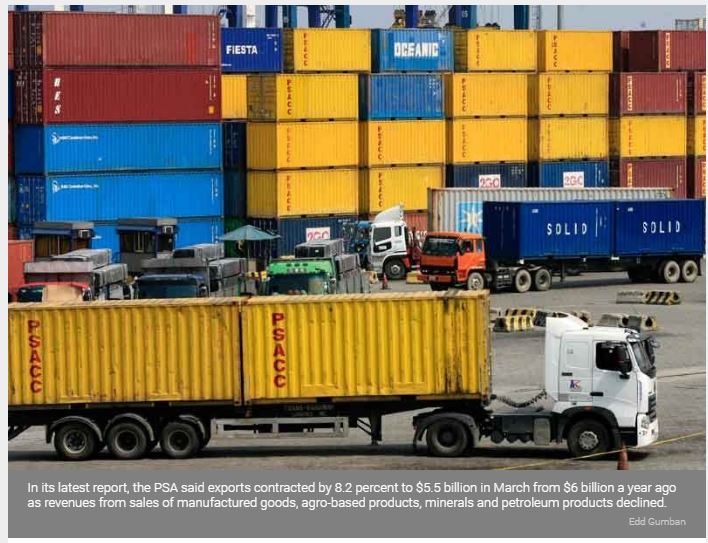Philippines: Trade deficit widens to $2.61 billion in March 2018
MANILA, Philippines — The country’s trade deficit widened by 24 percent to $2.61 billion in March as imports continued to outgrow exports for the fifth straight month, the Philippine Statistics Authority (PSA) reported yesterday.
In its latest report, the PSA said exports contracted by 8.2 percent to $5.5 billion in March from $6 billion a year ago as revenues from sales of manufactured goods, agro-based products, minerals and petroleum products declined.
Imports, on the other hand, inched up 0.1 percent to $8.12 billion last March due to the rise in payments for mineral fuels and lubricants, as well as iron and steel.
Economic managers, however, said a wide deficit could be tolerated amid the government’s massive infrastructure development program but at the same time, urge greater efforts to make sure exports remain viable.
Budget Secretary Benjamin Diokno said the country’s dependence on equipment and machinery imports needed to drive the ambitious infrastructure development program has caused the trade gap to expand.
“We are willing to tolerate that during President Duterte’s term because we are aggressively making up for past neglect in infrastructure,” he said.
He noted the deficit is not yet straining foreign exchange buffers as the country still has very robust reserves that continue to receive strong inflows from overseas Filipino workers and the business process outsourcing (BPO) industry.
“(Trade deficit of) $2.6 billion in proportion to the economy, that is very little, very small. We still have a very robust GIR (gross international reserves) and we continue to get around $50 billion from OFWs and the BPO sector so that should not be a concern,” said Diokno.
The GIR plunged to a fresh three-year low of $80.06 billion in April but BSP Governor Nestor Espenilla Jr. said at this level, the GIR still “serves as an ample external liquidity buffer.”
The GIR is the sum of all foreign exchange flowing into the country. The reserves serve as buffer to ensure that the Philippines would not run out of foreign exchange that it could use to pay for imported goods and services, or maturing obligations in case of external shocks.
The National Economic and Development Authority (NEDA), meanwhile, said the Philippines should double its efforts in marketing the country’s export products.
Socioeconomic Planning Secretary and NEDA chief Ernesto Pernia said short-term measures to boost trade may include providing government support to promising export products, demand for which is growing.
“This may include easing of government regulation, strengthened market intelligence gathering in partnership with the private sector, and maximizing the opportunities of trade agreements and economic groupings particularly within the Asian region,” he said.
He urged the Department of Trade and Industry to continuously encourage exporters to innovate and improve export quality by providing more access to testing, certification and accreditation that will enable compliance with international quality standards.
Pernia said the government is working on increasing the share of halal goods to 11 percent of total exports through the recent establishment of the National Halal Certification Scheme.
He also stressed the need to intensify the efforts of the country’s trade missions abroad, including business-matching initiatives in order to create new markets for Philippine-made goods.
“Exporters need to be provided with updated information that would enable them to tap countries with a huge market base to diversify their markets and decrease their vulnerabilities,” said Pernia. – With Mary Grace Padin
Source: https://www.philstar.com/business/2018/05/10/1813717/trade-deficit-widens-261-billion-march-2018#yTIeIwwO0o9KOw3l.99


 English
English




